2005 – Chapter One
Our tenth consecutive season of endurance racing was to be notable for a number of reasons. Tim Gooding and I have been racing together since 1989. We began endurance racing in 1993 and began contesting for the national championship in 1994. After winning six consecutive titles (1999-2004) we discovered that we had run into a problem of diminishing emotional returns. From 1994-1998 our team pretty much sucked. We blew up regularly. We rode too slow. We had poor pit strategies. We didn’t focus on the right aspects of the sport to improve.
In 1999 it all came together and we won our first title and no one was more surprised than we were. And then we kept winning. We won races, we won championships, we had to race against better funded teams, teams with better riders and teams with deeper resources but we were able to push through and battle, race after race, to eek out wins. Some seasons were tougher than others but after we beat Vesrah’s middleweight superbike team in 2002 there was a structural paradigm shift in the series. We officially became the top dogs in middleweight superbike.
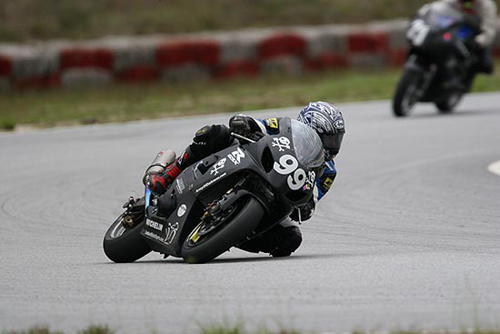
The slow cautious pace that typifies endurance racing.
We reinforced that perspective by winning every single race in 2003. Ten class wins and nine second overall places. We went into every event believing that we would win. Everyone else went into the events thinking that we would win as well. This becomes a problem.
As far as I can discern there are two emotional rewards in racing motorcycles. The first is winning races. The second is more sublime and gradually diminishes the strength of the first. The second greatest reward in motorcycle racing is exceeding expectations. If you expect to get 15th and you get 12th you have had a good day at the track. If you expect to turn 1:28.5 at a track and you run 1:27s you are ecstatic. Exceeding one’s own expectations is good, exceeding the expectations of others is even better.
So what happens when you win every race? What happens when you cannot exceed your own expectations? When it becomes impossible to exceed expectations then race weekends become a maintenance habit; the winning becomes merely satisfying and losing becomes horrible. Despite the decrease in the emotional return of winning the effort required to continue to win remains the same or escalates. Winning is never easy and to set the pace requires vast amounts of time and capital to stay at the top.
At the fifth engine rebuild of the season some of the novelty wears off and the preparation is no longer invigorating; it becomes a chore. Suzuki’s abysmal valve trains slowly drain the enthusiasm for lovingly porting a head since one knows that the casting will ultimately be destroyed when a valve tip breaks off, or a retainer cracks, or any of the other myriad problems that the GSX-R 600 has suffered since 2000. The effort to win remains the same but the rewards of winning have been eroded by expectation.
And so, Tim and I looked at each other at the beginning of the 2005 season and said “Is this it?” Following Lance Armstrong we decided to win the 2005 championship and see if it felt right during the season to start a long slow slide into obscurity.
However, like Lance, we wanted to go out on top and that meant building a team and fielding some serious equipment because rumors were already flying about who we would be racing in 2005.
Melissa Berkoff had decided to put her team on hiatus for a year while she sampled the lightweight class riding with a “just for fun” team Notorious P.I.G with Chris Eklund, Steve Bacon and Nolan Ballew. This left her previous teammate Scott Fisher available for us to grab. Ben Walters wanted to race again in 2005 so we decided that our core riders would be Ben Walters, Scott Fisher and myself, Sam Fleming.
Although the previous year we had decided to use the 2003 model GSX-R we decided to move platforms in the erroneous hope that the new titanium valves were more durable that the older steel ones. That turned out to be a faulty assumption but, of course, we didn’t know that then.
Loudoun Motorsports in Leesburg Virginia had been helping us out with bikes for a few years and wheeled two 2005 GSX-R 600s out to our van. We drove them home, stripped them down and proceeded to make them faster, lighter, more durable and endurance ready. This involved installing suspension from Traxxion Dynamics, Vesrah brakes, fairing stays from Morse Racing, bodywork from GP composites, Sprocket Specialist and, of course, Michelin tires. To make the bike lighter we installed a smaller battery, a beautiful aluminum endurance tank we bought off of the Vesrah team and a titanium exhaust from M4.
Tim completely reworked the motors using our past knowledge of the GSX-Rs to achieve an increase of about 20% in torque and a boost of about 10% in bhp. Tim also made quick change axles, spacers and assorted other parts so that we could swap wheels, add oil and refuel in under thirty seconds. Tim also installed our long suffering Drack data logging system to allow us to record any sensor as well as RPM and speed data around each track for each rider.
When we were done (which of course took about a hundred hours for each of the two bikes) we had two bikes of similar power with the A bike weighing about fifteen pounds less than the B bike. We heaved all the bikes, the gear, the tools, the wheels, the spare parts and the dump cans and headed south to the first round.
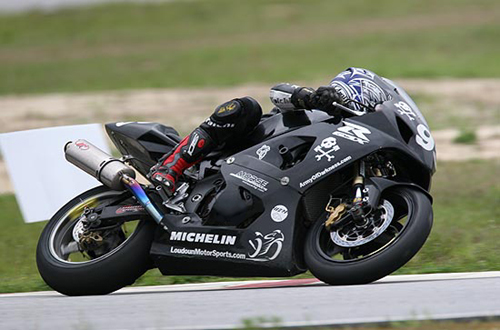
At the beginning of the season the exterior finish of the motorcycle, like our
hopes and dreams, is as yet unmarred by travails of the contest.
North Florida Motorsports Park
Jennings, FL
March 24-26, 2005
•••••••••••••••••••••••
During the many long hours of applying thread locking compounds to various fasteners or watching the metal curl out of 1/16th holes appearing at the end of the drill bit I had ample opportunity to contemplate a variety of topics. Interspersed around theories of art, politics, business, economics, philosophy and physics there appeared the theory of relative trailer size.
I, like many veteran racers, have been through a number of trailers. This starts with the humble three rail, then the single axle enclosed, then the double axle enclosed, then, when I realized we would be hauling two teams worth of everything around the countryside, the 28’ X 8’ behemoth which currently houses the effort. Being that is hauls for two and sometimes three teams that means that the actual square footage per team is still on par with most other small endurance teams but it is certainly a contrast physically to many other trailers in the paddock. Although certainly not the largest it is exactly the sort of physical manifestation of “A large team” that we used to delight in humbling.
As we backed this black monstrosity into place in the pits directly across from the tiny trailer of two of this season’s competitors I recognized that, had I no personal involvement in the contest, I would be rooting for one of the small trailer teams to beat the big trailer team. Looking out from the big trailer, however, gave me a different perspective.
We greeted friends around the pits, surveyed the various changes to various teams and assessed the competition. The team that looked like the most likely to be able to challenge us was Bell’s Suzuki. The Bell brothers has put up a very formidable lightweight team in 2004 before losing the championship to our satellite team Dixie Mafia in the last round. They had switched to Middleweight Superbike and had what looked to be a very serious piece of equipment dripping with very expensive wheels, suspension and other accoutrements. However, on Thursday the bike was still without a motor (a fatality of Daytona) which diminished the threat to some extent.
The other team of note was Red Star. Although they were working out of a small trailer it was impossible not to notice the sheer quantity of people they had in the pits. Red Star was captained by William Lindsay who had ridden four or five races with us eleven years ago in 1994. He quit the team half way through the first season. While AOD struggled with national endurance racing for the next few five years Lindsay achieved some notable success in regional sprint racing in the mid-Atlantic region. He eventually suffered a severe crash that lead to some big orthopedic injuries. For most guys this would have ended their racing hobby but Will iam came back after a long rehabilitation process.
Now, as we are both from DC we have, to some extent, overlapping social circles. Through this grapevine we have heard many stories over the years told by Lindsay about how we (well, specifically, I) had mistreated William when we were teammates and how those indignities had fired a resentment that would only be quenched by beating us for the 2005 championship. This personal dimension, of course, complicated an already serious contest. Lindsay’s primary teammates for the season would be the very fast Ben Thompson, the increasingly fast Brent Champagne, the past national endurance champion Joe Prussiano and the very fast Larry Denning.
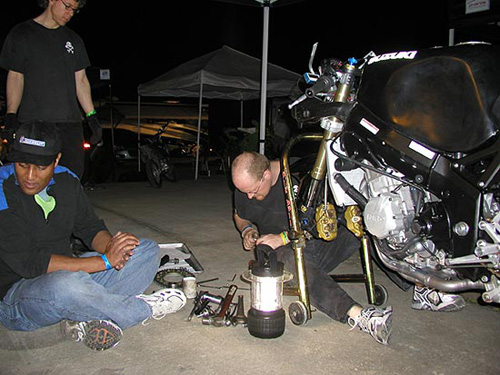
Tim and Nolan reassemble the front end after the fork upgrade while Chris Eklund looks on.
Compared to our 2003 race bike the 2005 felt very light and nimble. The forks and the swingarm had much more torsional rigidity which seemed to make the bike more sensitive to set up. We tried using the set-up from the prior year but the stiffer chassis seemed to be more demanding on the tires and we had to step up to a harder rear to prevent tearing. Ben and I both liked the bikes and were feeling pretty comfortable since we were setting times notably faster than our counterparts on the other teams.
Scott Fisher flew into the track from Las Vegas but immediately had to turn around and return to the airport. Scott has a bit of an odd job and at that moment the global economy required that he fly from Florida to California to program computers to properly fly Tinkerbell across Disneyland on thin wire rope.
Although Ben and I felt comfortable with the race it is never a great idea to not have backup so we recruited fellow Michelin rider Robert Jensen to take a stint as well. He absolutely hated our bike but went really fast on it so we cheerfully shrugged of his critique.
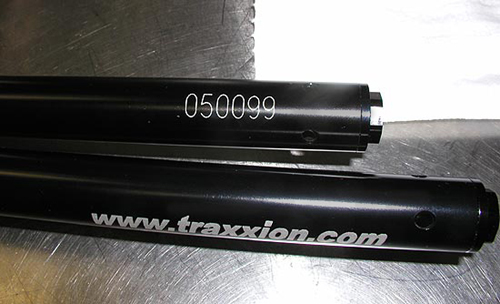
Custom built black AK-20 cartridges our forks with the 99 serial number.
It's like they were made for us.
At the end of the day we huddled under the canopies as the sun set while Tim ran through a comprehensive list of things to check on the new bikes and Max McAllister upgraded our forks from the revalved stock cartridges to a set of his custom made AK-20 cartridges. As we were rolling the bikes into the trailer the rain began to fall.
The rain fell and the water rose and the pits became a toxic swamp of flood water mixed with a film of oil and fuel. When we arrived in the morning of the official practice some teams were carrying submerged equipment to higher ground. Resting on our fast lap laurels from the prior day we stayed dry in the van and watched “Faster” on a laptop.
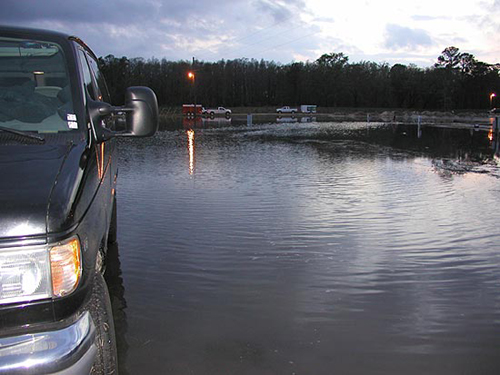
The pits at North Florida at first practice. We were Katrina before Katrina was cool.
We eventually dug a bike out of the trailer and good naturedly turned a few tepid laps on the damp track.
Race day dawned without much improvement with the weather. Although most of the floodwaters had receded we had a wet track for practice that dried right before the start. With slicks on the bike a downpour (complete with hail) came through forcing many teams (including ours) to scramble for rains. We had already imposed on Michelin tire man Walt Schaeffer by having him prophylacticly mount rains, slicks and intermediates for us. With hail falling from the sky I held a tarp while Tim swapped the slicks for rains just in time for the sun to break through the clouds. On the grid there were four teams which had chosen to start the race with rain tires; the rest elected to run DOTs or intermediates.
The rain passed by, the sun broke through and the green flag fell. Ben made excellent use of the rains on the soaked track. He ran with the lead group and lapped up to fifth place. Unfortunately a red flag came out and the track continued to dry during the break. Having lapped most of the field we would be taking the restart a full lap up on all but four other teams.
At the restart the track was too dry for the rains and we pitted quickly to get back out on slicks. The red flag drying session cost us some of our advantage but we were able to make up most of it with fast pit work.
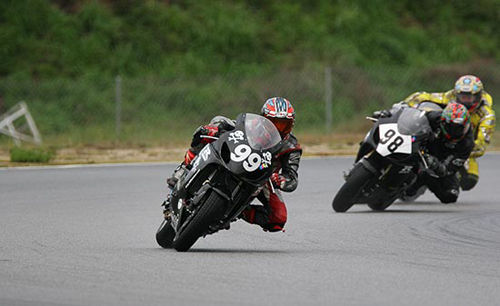
Nothing is better than rains on a wet track.
Of course, nothing is worse than rains on a dry track.
Ben ran out the tank and we switched to new tires and Robert Jensen. Jensen said one thing before he left the pits “I am not riding in the rain” and then went out to almost put in the fastest lap of the entire race of any team in the race, a 1:19.27 compared to a 1:19.1 from Vesrah on their 1000.
Forty-five minutes into his stint the rain came down again and we pitted for rain tires, fuel and a rider who is most decidedly not made of sugar. I took the bars and concentrated on working my times down while being very careful not to throw the bike away from our front running position. Riding around on rains when virtually everyone else is on DOTs or slicks is very good for one’s ego because you can cut and thrust and carve and accelerate all while they tip toe around. I was able to stretch out our lead even further.
Eventually the rain stopped and the track started drying. The rain tires slowly overheated and dissolved on the dry track and as soon as the first bike passed me back on DOT’s I signaled the crew to prepare slicks and Ben.
We had a fast pit stop and with new Michelin slicks Ben took the track with a comfortable lead and stretched it out to the checkered flag. We finished first in class and second over all. Redstar finished second in class about a lap and a half down and Bell’s Suzuki finished in third six laps down. Same Shit, Different Year. The effort was expended and the expectations met.
Autobahn Country Club
Joliet, Illinois
May 7, 2005
•••••••••••••••••••••••
In a different time Jake and Elwood could have taken their ’74 Monaco straight from the release gate at the Joliet Correctional Facility over to the Autobahn Country Club for a few laps. However, even given the local standard of moonscape that passes for pavement in the greater Chicagoland area, Autobahn’s bump, ripples, and ruts would have given the cop suspension a workout.
The Autobahn track is a simple layout and, despite the bumps, Ben was going really quick in practice. Scott Fisher (freed from the constraints of the magic kingdom) was really fast in practice as well; faster and smoother than I remember seeing him ride ever before. I struggled with the bumpy course but eventually just sucked it up and started turning some respectable times.
Comparing our times with the competition we entered the race cautiously optimistic for a good result.
Ben Walters started the race for us but he didn’t get a good start and Ben Thompson (Red Star) and Roger Bell (Bell’s Suzuki) were able to create a seven second gap that Ben Walters (AOD) was then able to maintain.
Even though we were only twenty minutes into the four hour race Tim and I started running pit stop calculations figuring that we could more than make up the seven seconds on rear tire changes when the call came though that our brand stinkin’ new Suzuki is out with a mechanical.
With the bile rising in our throats Tim and I considered our options. We were about eighteen laps into the race. We could restart on our B bike and forfeit those eighteen laps or we could wait for the bike and see if it is something we can fix in less than eighteen laps. Our cogitation wasted time but after ninety seconds or so I declared “Go with the B bike” and we tossed a rear wheel on it and threw Scott out on the track.
We were very disappointed because this would allow both Red Star and Bell’s to overtake us in the points. With seven teams in the class we were looking at a disastrous finish. Bell’s Suzuki blew their second GSX-R motor of the season shortly thereafter leaving Red Star alone in the lead. Red Star took second overall and first in class while we came home 31st overall, 5th in class and firmly behind the eight ball.
With pieces of exhaust valve rattling around in our exhaust pipe we slowly packed the trailer and generally wallowed in self-pity. With only thirteen days until the next round we would have to locate, purchase and prepare another race motor for the bike and then try to slowly dig ourselves out of a massive points deficits if we were to have any chance of taking our seventh championship.
In between making procurement lists and placing calls to potential sources for used engines around DC, Tim and I were finally able to lighten the mood by joking “The lengths we go to keep the underdog status.”
